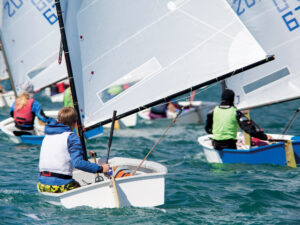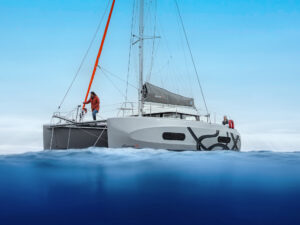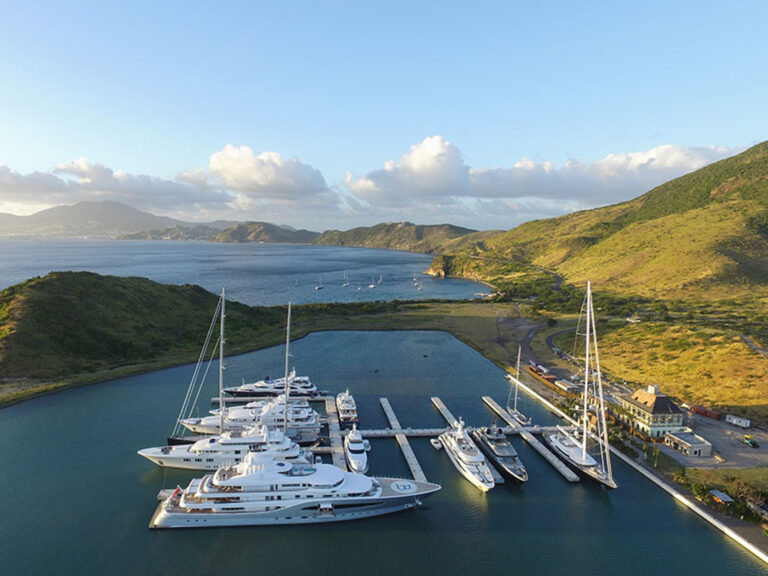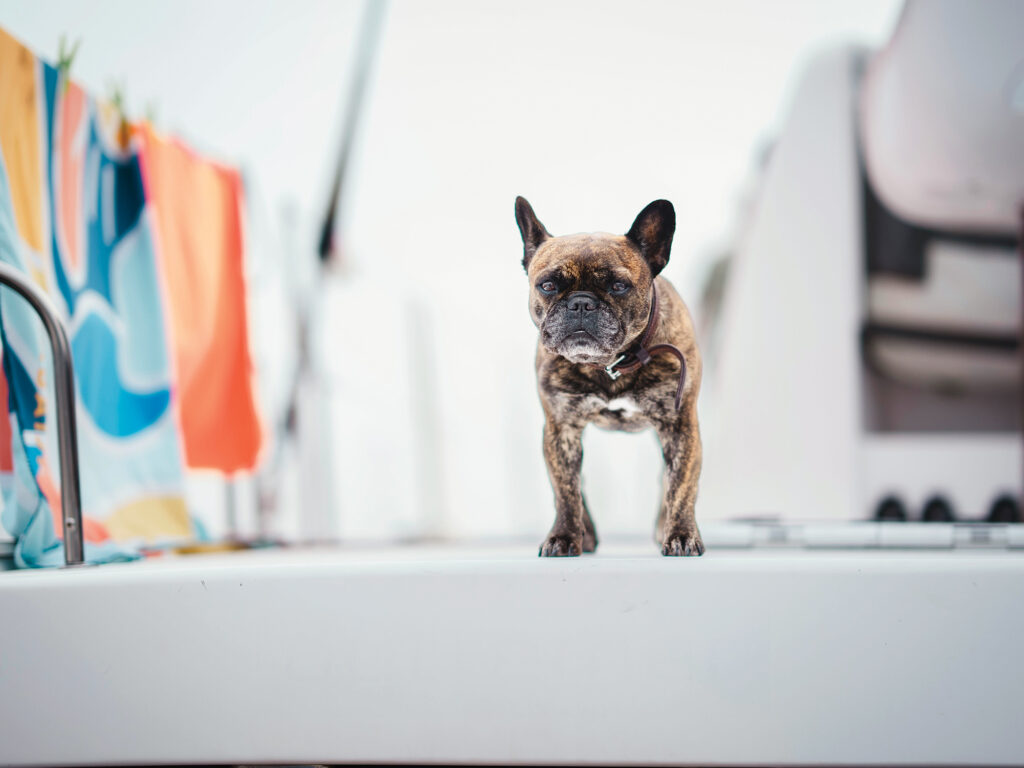
2024 Atlantic Rally for Cruisers was big on numbers: 234 yachts, the 39th running of the transatlantic rally, 45 multihulls—and a half-dozen pets. The biggest among them was Snow, the Great Dane who made the crossing on the Belgian-flagged—ahem—Great Dane.
“Snow is probably the largest dog to have ever sailed with the ARC,” says Rachel Hibberd, the head of communications for the World Cruising Club.
Snow weighs in at around 160 pounds and stands just over 3 feet tall. She eats more than a pound and a half of dog food a day, plus lots of snacks. There’s a special spot at the business end of her family’s 2018 Fountaine Pajot Saona 47, off the port pontoon for…
“We get asked that a lot: Where does she do her business?” says Sophie Ingels, who, with Sven Bruynooghe, worked from home in Belgium and had two merle Great Danes. They sold their business and traveled throughout Europe with the dogs in a camper van. Sven tested a few sailboats in the Caribbean and suggested they try cruising on a Fountaine Pajot.
“When Sven proposed we get the boat, I said, yes, but the dogs are coming too,” Ingels says.
They sailed the Mediterranean for six months. When they realized that boat life actually worked with the Great Danes, they decided to join the ARC and cross the Atlantic. Sadly, one of their dogs has since passed away, but Snow has adjusted to multihull life like a champ.
There are a few challenges with having a pet on board—and a lot of benefits, Sophie and other sailors with dogs say. Each leg of a voyage requires additional planning, paperwork and provisioning.
“We look at everything Benji might need quite a long time in advance,” says Mark Belcher, who along with his wife, Penny, sailed in the ARC with their Maltese.
A rabies vaccination has to be done in advance, Mark says, to prove it has worked. In St. Lucia, for example, the titer test needs to be dated at least three months prior to arrival.
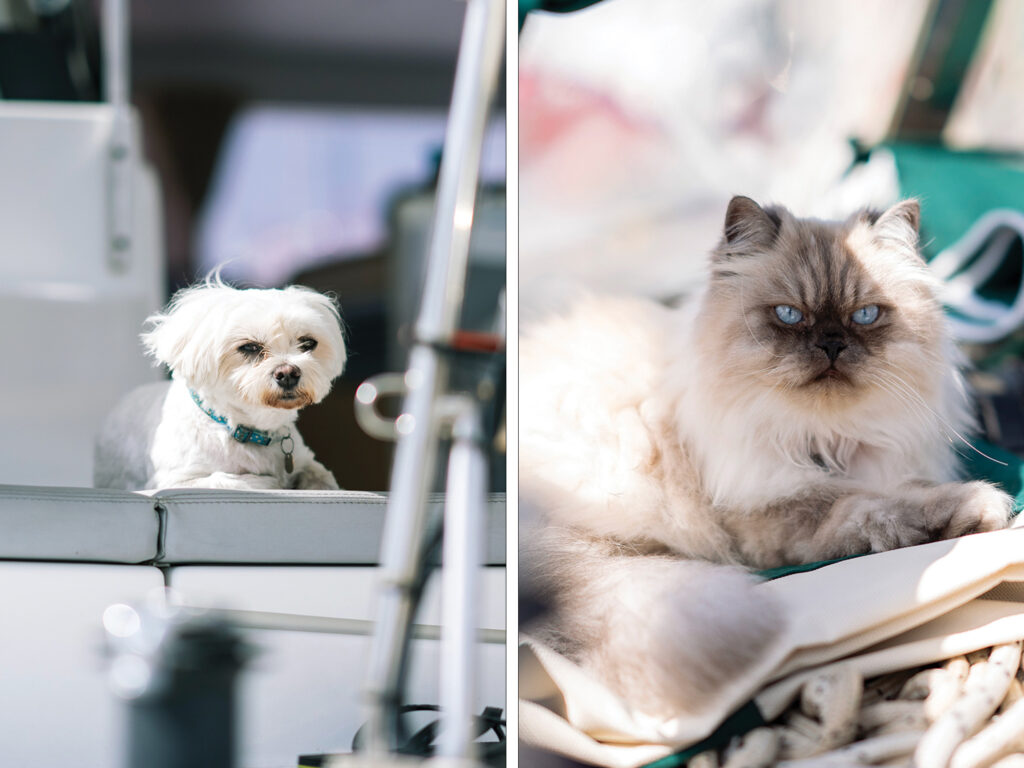
In addition, different countries accept records from only certain testing sites, so an owner must search them out. In the United Kingdom, there are two. In the United States, there are only two or three that are accepted universally, he says.
“Other tests needed to be done in Las Palmas, because the tests need to be done within 14 days of departure—but then there’s the whole problem of getting the results back from the lab in time,” he says, adding that the dog also needs a health certificate, an export permit and an import permit. “You end up with a massive file of paperwork for Benji, and we just have our passports.”
Benji, for his part, enjoys a fast dinghy ride when leaving the family’s Lagoon 400, Two Hoots—fast enough that his white ears flap in the breeze—and he shows a strong interest in the cheese-and-ham snacks at shoreside cafes.
Snow, however, has different tastes.
“Snow didn’t get off the boat once in the Mediterranean. She occasionally does fall in, and just paddles around until we get her out,” Sophie says. “Moving around the European Union was not difficult, but we had to deal with some paperwork to get her into Morocco. The Caribbean is more of a challenge.”
In order for Snow to go to St. Lucia, she needed three trips to the vet in Las Palmas to fulfill requirements for blood samples, health reports and export. Given how strict St. Lucia is, a few ARC+ sailors with pets opted for a Grenada landfall.
“It’s been a nightmare,” says Sonia Johal, who sails with her Chihuahua, Buoy, on her Hanse 385, Salacia. “To leave the UK, you need to have an export permit, then France gave us an import permit, and sailing the EU was fine. But we had a hard time leaving Las Palmas. I thought I had all of the paperwork in order from my vet. It was a challenge.
“But I love having a pet on board,” she adds. “I sail solo most of the time, and Buoy is good company. He makes me happy. He makes me laugh and, really, he puts life into perspective. If something goes wrong, you can get a little bit fed up sometimes, you turn around and look at Buoy, and it’s like, ‘I get it, it’s all good.’”
The Smith-Haywood family on the 1991 Tayana 47 Apres Ski feels the same way about their nine-year-old Blue Point Himalayan, Cappuccino, who, along with Pablo Escobar on the Lagoon 42 Mahalo, are two of the fluffiest cats to have ever crossed the Atlantic.
Annika Haywood, Lloyd Smith and their two kids adopted Cappuccino in Saudi Arabia. They lived aboard Apres Ski and worked in the Middle East for 12 years. Smith was director of the Coastal and Marine Resources Core Lab, part of the King Abdullah University of Science and Technology. Haywood did postdoctoral research on the genetics of sponges. When they departed Jeddah, sailed up the Red Sea and transited the Suez Canal, Cappuccino handled the headwinds like a champ, mostly sleeping and lying in the sun.
Cappuccino became a member of the EU in Cypress and didn’t care when the engine failed between Cyprus and Rhodes. He mostly enjoyed the five-month 4,300-mile trip across the Mediterranean to the Canary Islands, although he was notedly indifferent to the front-row seats for the America’s Cup in Barcelona, and was relatively unimpressed with Rhodes, Gallipoli, Rome, the Amalfi Coast, the Strait of Gibraltar, Tangier and Casablanca.
Meeting various nations’ rabies requirements is the biggest challenge, Haywood says, but as long as you have a certificate and the rabies vaccinations are repeated every 12 months, most countries are OK.
“Once we arrived in the Caribbean, we had our permit for St Lucia, but we have stuck to the French Islands otherwise, to simplify things,” she says. “We’ll do more paperwork to go to the US Virgin Islands, and then Panama and French Polynesia.”
The family is making their way, eventually, across the Pacific and home to New Zealand. “We have a really nice backpack for him and have taken him on a few adventures onshore,” she says. “We generally take him when we leave the boat for more than a few hours, or if we’re staying somewhere overnight.

“He went swimming once, after a miscalculated jump back to our boat,” she adds. “We were at a marina in Greece, and he was working his way down the dock, jumping from boat to boat. He’s a fantastic swimmer but a complete loony, and swam in circles around different boats. I had to get in and fish him out, and then Lloyd washed him down with fresh water. I have since put some netting around the boat.”
When they’re offshore, they keep the cat’s passport, rabies certificate and import permit in the overboard grab bag, and if the boat were to sink, “he comes with us on the life raft. We have a life jacket for him right in the companionway,” Annika says. “It is difficult to get annoyed with him. He is so darn cute. We all love him.”
When Two Hoots is offshore, Penny puts Benji in his harness, then puts on her own life jacket and takes him for a walk around the boat. He gets excited when he sees the lead, she says.
“Snow didn’t get off the boat once in the Mediterranean. She occasionally does fall in, and just paddles around until we get her out.”
When they’re sailing, Benji’s favorite spot on board is in Penny’s lap. He generally sleeps in the cabin if someone’s below. The Belchers got him a new toy for the Atlantic crossing, to keep him busy and wear him out.
“He’s so entertaining,” Mark says. “He gives you perspective and distraction. He’s sweet and loving, and so good for morale.”
He also doesn’t need many provisions, Mark adds: “We’ve got dog food, dried stuff, and he loves salmon, tuna, chicken. We take him with us when we eat onshore. He loves sea bass and sirloin. I’m looking forward to anchoring in some little Bahamian Bay with a little spit of sound, and Benji having free range, and he can just go nuts, run around in the sand. He absolutely adores the beach. When we were in Greece, he would just go running down, roll around in the water, go for a swim.”
Buoy spends a lot of time in a small dog carrier or on a lead on deck when the boat is away from shore. Snow stays under the cockpit table when the sails are up.
“She’s an ideal boat dog,” Sophie says. “If the weather is calm, she lies up front. If she sees dolphins, she barks. Sometimes at the dock or at anchor, if she sees someone, she howls. There are not a lot of safety concerns for the crew when she’s around.”

